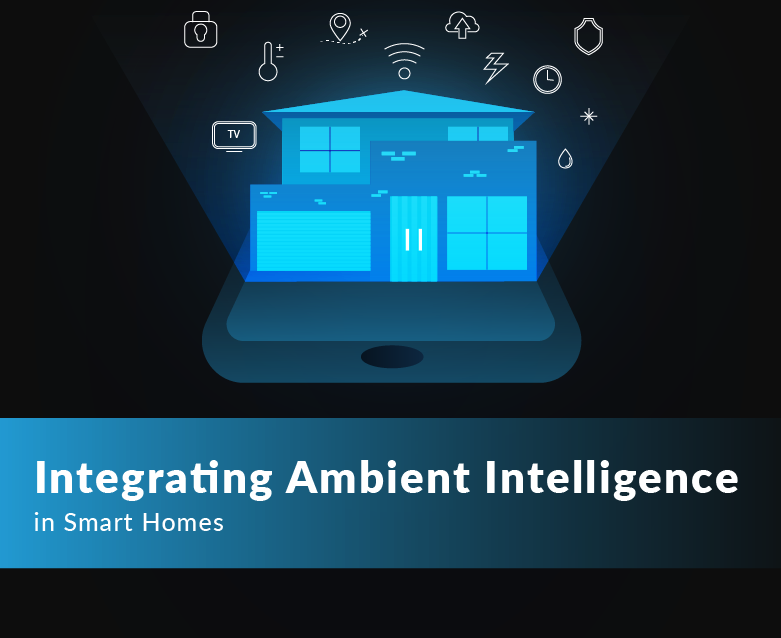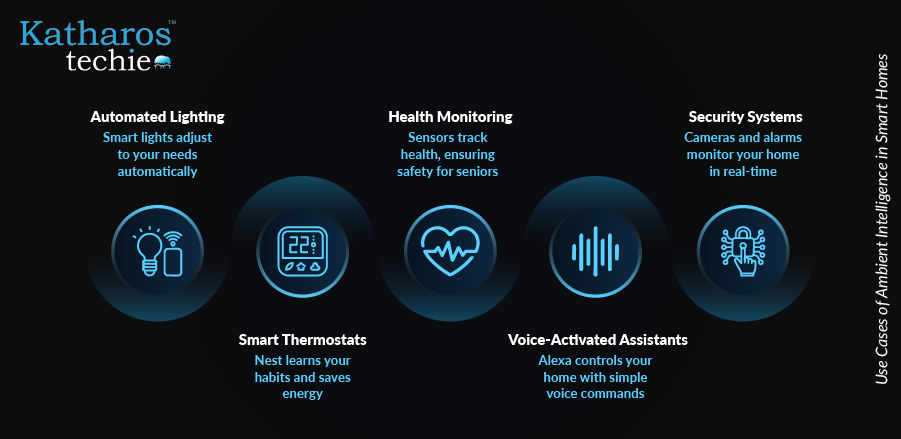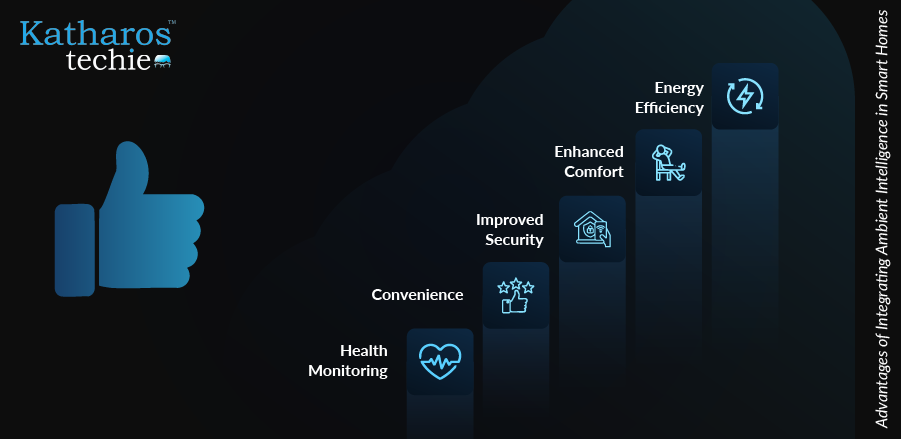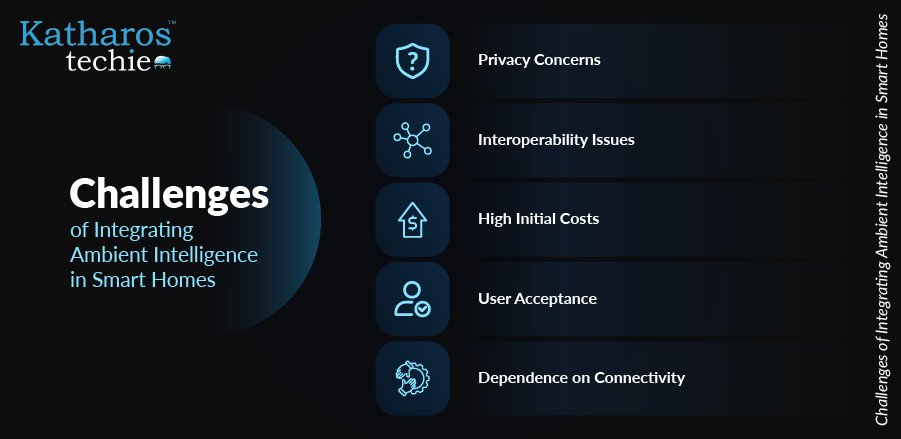
Integrating Ambient Intelligence in Smart Homes
By Ankita Das

Integrating Ambient Intelligence (AmI) in smart homes has revolutionized how we interact with our living spaces. By 2029, the ambient intelligence market is projected to reach USD 209 billion, reflecting its rapid growth and adoption. AmI combines artificial intelligence, the Internet of Things (IoT), and context-aware computing to create intuitive environments. These systems anticipate user needs, enhancing comfort and efficiency without requiring direct human input. As smart homes become increasingly prevalent, understanding the role of AmI is crucial for maximizing their potential. This blog explores the significance, use cases, advantages, and challenges of integrating Ambient Intelligence into smart homes.
What is Ambient Intelligence in Smart Homes?
Ambient Intelligence (AmI) is a technology framework that enables environments to respond intelligently to users’ needs through embedded sensors and AI. In smart homes, AmI systems utilize various devices to collect data about user behavior and environmental conditions. This data enables the system to make decisions that improve comfort, security, and energy efficiency.
Integrating AmI in smart homes is essential for several reasons. It promotes energy efficiency by automatically adjusting heating, cooling, and lighting based on occupancy and preferences. AmI also enhances user convenience through automation. Devices like Amazon Echo or Google Nest can manage home settings with voice commands, making daily tasks easier for users.
Additionally, AmI improves security by utilizing surveillance cameras and motion sensors that instantly detect unusual activities and alert homeowners. Ring doorbell cameras have been shown to reduce package theft by over 50% in monitored areas. Integrating Ambient Intelligence into smart homes creates a seamless living experience that adapts to individual needs while promoting efficiency and security.
Use Cases of Ambient Intelligence in Smart Homes

Ambient Intelligence (AmI) in smart homes encompasses a range of innovative applications that significantly enhance user experience and operational efficiency. These systems leverage advanced technologies to create responsive environments that adapt to individual needs seamlessly. Below are some prominent use cases of AmI.
- Automated Lighting: Smart lighting systems adjust brightness based on natural light levels or user presence. For example, Philips Hue lights can automatically dim when users start watching a movie, enhancing the viewing experience.
- Smart Thermostats: Devices like Nest learn user habits and adjust temperatures accordingly. They can pre-cool or heat homes before occupants arrive, ensuring comfort while saving energy.
- Health Monitoring: Sensors integrated into the home can track health metrics such as heart rate or activity levels. Systems like Philips Lifeline provide emergency alerts for seniors, allowing them to live independently while ensuring safety.
- Voice-Activated Assistants: Devices like Amazon Alexa enable hands-free control of various home functions. Users can manage lights, music, and appliances simply by speaking, making it easier for those with mobility challenges.
- Security Systems: Integrated cameras and alarms monitor homes in real time and alert homeowners to unusual activities. Ring doorbell cameras allow users to see and speak to visitors remotely, enhancing security.
These use cases demonstrate how Ambient Intelligence transforms ordinary homes into responsive living spaces personalized to individual preferences. In the next sections, we’ll discuss the advantages of having AMI in your home and the challenges we need to know.
Advantages of Integrating Ambient Intelligence in Smart Homes

Integrating Ambient Intelligence into smart homes provides numerous benefits, enhancing households with personalized and efficient environments. The following points highlight the key benefits of incorporating AmI into smart homes:
- Energy Efficiency: AmI systems optimize energy use by adjusting appliances based on occupancy, reducing energy consumption. This leads to significant cost savings and promotes environmental sustainability in households.
- Enhanced Comfort: AmI personalizes environments by learning user preferences, automatically adapting to individual needs, and enhancing comfort. This ensures a personalized and enjoyable living experience within the smart home.
- Improved Security: Real-time monitoring systems provide alerts for suspicious activities, improving home security through prompt notifications. This enables homeowners to respond quickly and ensures greater safety within the living space.
- Convenience: Automation simplifies routine tasks, making home management more convenient through voice commands or mobile apps.
- It streamlines routines and maximizes convenience for enhanced user satisfaction in their daily lives.
- Health Monitoring: AmI supports health management through vital sign tracking, alerting caregivers about anomalies, and improving well-being. This proactive health monitoring allows for timely interventions and promotes healthier living for residents.
These benefits illustrate how integrating AmI significantly improves the quality of life and promotes a more sustainable lifestyle. However, while the advantages of integrating Ambient Intelligence into smart homes are substantial, it is equally important to address the challenges.
Challenges of Integrating Ambient Intelligence in Smart Homes

Integrating Ambient Intelligence into smart homes presents significant challenges that must be addressed for successful adoption. The following points outline key challenges that need to be taken into consideration for effective integration:
- Privacy Concerns: Extensive data collection raises significant privacy issues, making users worry about the security of their personal information. Protecting user data and ensuring transparency are critical for building trust in these systems.
- Interoperability Issues: The variety of devices operating on different platforms creates compatibility challenges, affecting seamless integration in smart homes. Setting industry standards is crucial for ensuring that devices can communicate effectively, regardless of the manufacturer.
- High Initial Costs: The expensive upfront investment for smart home technologies can be prohibitive for many consumers. Thus, resulting in limited widespread adoption. Balancing the cost of implementation with the long-term benefits is essential for making AmI accessible to a broader audience.
- User Acceptance: Some individuals resist adopting new technologies due to concerns about complexity or a lack of understanding of their benefits. Simplifying user interfaces and providing comprehensive education can encourage greater acceptance of these advanced systems.
- Dependence on Connectivity: AmI systems heavily rely on stable internet connections; disruptions can severely impact functionality. Ensuring reliable connectivity and designing systems that can function during outages are essential for maintaining consistent performance.
Addressing these challenges is crucial for adopting Ambient Intelligence in smart homes. This will make the technology more reliable and easier to use, ensuring smart homes meet people’s needs.
Integrating Ambient Intelligence into smart homes represents a transformative shift toward more responsive living environments. While challenges exist, the benefits such as enhanced comfort, energy efficiency, and improved security are compelling. As technology evolves, embracing these innovations will be essential for creating smarter living spaces. Explore how you can implement Ambient Intelligence solutions in your home today.